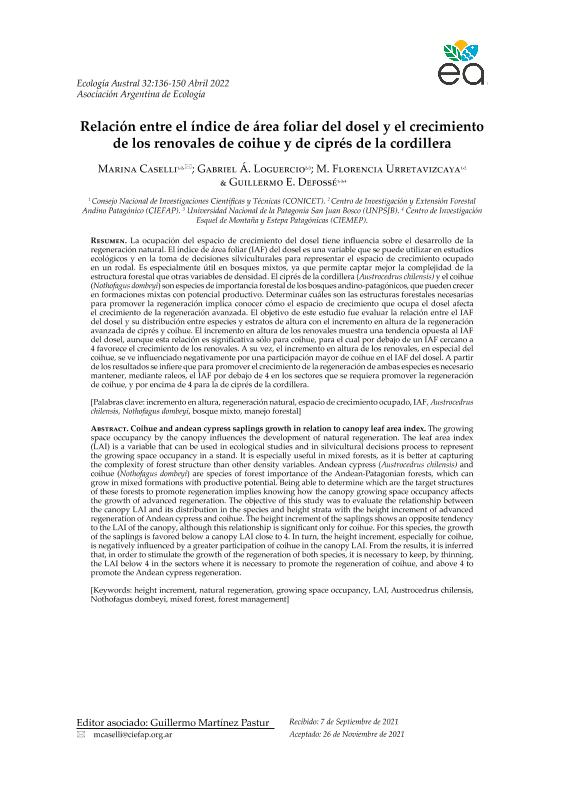Mostrar el registro sencillo del ítem
dc.contributor.author
Caselli, Marina

dc.contributor.author
Loguercio, Gabriel Angel

dc.contributor.author
Urretavizcaya, María Florencia

dc.contributor.author
Defossé, Guillermo Emilio

dc.date.available
2023-06-09T16:41:04Z
dc.date.issued
2022-01
dc.identifier.citation
Caselli, Marina; Loguercio, Gabriel Angel; Urretavizcaya, María Florencia; Defossé, Guillermo Emilio; Relación entre el índice de área foliar del dosel y el crecimiento de los renovales de coihue y de ciprés de la cordillera; Asociación Argentina de Ecología; Ecología Austral; 32; 1; 1-2022; 136-150
dc.identifier.issn
0327-5477
dc.identifier.uri
http://hdl.handle.net/11336/200121
dc.description.abstract
La ocupación del espacio de crecimiento del dosel tiene influencia sobre el desarrollo de la regeneración natural. El índice de área foliar (IAF) del dosel es una variable que se puede utilizar en estudios ecológicos y en la toma de decisiones silviculturales para representar el espacio de crecimiento ocupado en un rodal. Es especialmente útil en bosques mixtos, ya que permite captar mejor la complejidad de la estructura forestal que otras variables de densidad. El ciprés de la cordillera (Austrocedrus chilensis) y el coihue (Nothofagus dombeyi) son especies de importancia forestal de los bosques andino-patagónicos, que pueden crecer en formaciones mixtas con potencial productivo. Determinar cuáles son las estructuras forestales necesarias para promover la regeneración implica conocer cómo el espacio de crecimiento que ocupa el dosel afecta el crecimiento de la regeneración avanzada. El objetivo de este estudio fue evaluar la relación entre el IAF del dosel y su distribución entre especies y estratos de altura con el incremento en altura de la regeneración avanzada de ciprés y coihue. El incremento en altura de los renovales muestra una tendencia opuesta al IAF del dosel, aunque esta relación es significativa sólo para coihue, para el cual por debajo de un IAF cercano a 4 favorece el crecimiento de los renovales. A su vez, el incremento en altura de los renovales, en especial del coihue, se ve influenciado negativamente por una participación mayor de coihue en el IAF del dosel. A partir de los resultados se infiere que para promover el crecimiento de la regeneración de ambas especies es necesariomantener, mediante raleos, el IAF por debajo de 4 en los sectores que se requiera promover la regeneración de coihue, y por encima de 4 para la de ciprés de la cordillera.
dc.description.abstract
The growing space occupancy by the canopy influences the development of natural regeneration. The leaf area index (LAI) is a variable that can be used in ecological studies and in silvicultural decisions process to represent the growing space occupancy in a stand. It is especially useful in mixed forests, as it is better at capturing the complexity of forest structure than other density variables. Andean cypress (Austrocedrus chilensis) and coihue (Nothofagus dombeyi) are species of forest importance of the Andean-Patagonian forests, which can grow in mixed formations with productive potential. Being able to determine which are the target structures of these forests to promote regeneration implies knowing how the canopy growing space occupancy affects the growth of advanced regeneration. The objective of this study was to evaluate the relationship between the canopy LAI and its distribution in the species and height strata with the height increment of advanced regeneration of Andean cypress and coihue. The height increment of the saplings shows an opposite tendency to the LAI of the canopy, although this relationship is significant only for coihue. For this species, the growth of the saplings is favored below a canopy LAI close to 4. In turn, the height increment, especially for coihue, is negatively influenced by a greater participation of coihue in the canopy LAI. From the results, it is inferred that, in order to stimulate the growth of the regeneration of both species, it is necessary to keep, by thinning, the LAI below 4 in the sectors where it is necessary to promote the regeneration of coihue, and above 4 to promote the Andean cypress regeneration.
dc.format
application/pdf
dc.language.iso
spa
dc.publisher
Asociación Argentina de Ecología

dc.rights
info:eu-repo/semantics/openAccess
dc.rights.uri
https://creativecommons.org/licenses/by/2.5/ar/
dc.subject
incremento en altura
dc.subject
regeneración natural
dc.subject
espacio de crecimiento ocupado
dc.subject
IAF
dc.subject
Austrocedrus chilensis
dc.subject
Nothofagus dombeyi
dc.subject
bosque mixto
dc.subject
MANEJO FORESTAL
dc.subject.classification
Silvicultura

dc.subject.classification
Agricultura, Silvicultura y Pesca

dc.subject.classification
CIENCIAS AGRÍCOLAS

dc.title
Relación entre el índice de área foliar del dosel y el crecimiento de los renovales de coihue y de ciprés de la cordillera
dc.title
Coihue and andean cypress saplings growth in relation to canopy leaf area index
dc.type
info:eu-repo/semantics/article
dc.type
info:ar-repo/semantics/artículo
dc.type
info:eu-repo/semantics/publishedVersion
dc.date.updated
2023-06-09T15:24:03Z
dc.journal.volume
32
dc.journal.number
1
dc.journal.pagination
136-150
dc.journal.pais
Argentina

dc.description.fil
Fil: Caselli, Marina. Consejo Nacional de Investigaciones Científicas y Técnicas; Argentina. Centro de Investigación y Extensión Forestal Andino Patagónico; Argentina
dc.description.fil
Fil: Loguercio, Gabriel Angel. Centro de Investigación y Extensión Forestal Andino Patagónico; Argentina. Consejo Nacional de Investigaciones Científicas y Técnicas; Argentina. Universidad Nacional de la Patagonia "San Juan Bosco"; Argentina
dc.description.fil
Fil: Urretavizcaya, María Florencia. Centro de Investigación y Extensión Forestal Andino Patagónico; Argentina. Consejo Nacional de Investigaciones Científicas y Técnicas; Argentina
dc.description.fil
Fil: Defossé, Guillermo Emilio. Consejo Nacional de Investigaciones Científicas y Técnicas. Centro Científico Tecnológico Conicet - Patagonia Norte. Centro de Investigación Esquel de Montaña y Estepa Patagónica. Universidad Nacional de la Patagonia "San Juan Bosco". Centro de Investigación Esquel de Montaña y Estepa Patagónica; Argentina
dc.journal.title
Ecología Austral

dc.relation.alternativeid
info:eu-repo/semantics/altIdentifier/url/http://ojs.ecologiaaustral.com.ar/index.php/Ecologia_Austral/article/view/1857
dc.relation.alternativeid
info:eu-repo/semantics/altIdentifier/doi/http://dx.doi.org/10.25260/EA.22.32.1.0.1857
Archivos asociados
